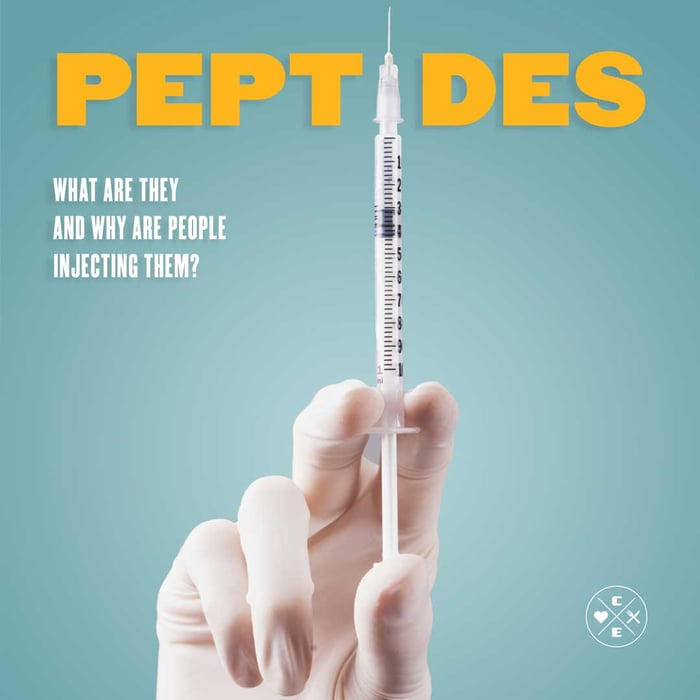Peptides: What They Are & Why People Inject Them

Dorothy M. Shirnyl, RND
Nutrition
|
Healthy Lifestyle
09/30/2025 2:09pm
5 minute read
What are peptides?
Peptides are short chains of amino acids—think “mini-proteins.” Your body uses them as hormones and signaling molecules (insulin, GLP-1, etc.).1, 2
Why people inject peptides
Popular reasons include fat loss, appetite control, muscle gain, injury recovery, sexual health, and even tanning. Some of these goals have approved peptide drugs behind them; others are driven by unapproved “research” products marketed online.
Two very different categories
1) FDA-approved peptide medicines (prescription)
- GLP-1/GIP-based therapies for weight management: semaglutide (Wegovy) and tirzepatide (Zepbound) have robust RCT evidence for significant, sustained weight loss when paired with lifestyle changes.3, 4
- Condition-specific peptide drugs: tesamorelin for HIV-associated lipodystrophy (not a weight-loss drug), and bremelanotide for HSDD in premenopausal women.
2) Unapproved “research” peptides marketed for fitness/anti-aging
Common names include BPC-157, TB-500/Thymosin beta-4 fragments, AOD-9604, CJC-1295, ipamorelin, PEG-MGF, and Melanotan I/II. These are not FDA-approved; several appear on an FDA list of substances that may pose significant safety risks, and regulators warn against their use.5, 6
What the evidence says (weight loss, muscle, “healing”)
- Weight loss: Prescription GLP-1/GIP therapies (semaglutide/tirzepatide) consistently produce large weight reductions in RCTs when combined with lifestyle changes.3, 4 Labels also outline important risks (e.g., gallbladder, GI effects, rare pancreatitis signals, and a boxed thyroid tumor warning for semaglutide).7, 8
- Muscle gain/performance: Online-sold peptides (e.g., CJC-1295, ipamorelin, PEG-MGF) lack high-quality human trials for physique outcomes; some carry specific safety concerns flagged by FDA.5
- “Healing”/injury recovery: Claims around BPC-157/TB-500 are not supported by FDA-approved indications; BPC-157 is an unapproved drug and prohibited for sport.5, 9, 10
- Tanning: Melanotan products (nasal sprays/injectables) are illegal to sell in several countries and carry safety warnings from regulators.6
Safety, legality & sports rules
- Unapproved ≠ off-label: Off-label use applies only to FDA-approved drugs. Most “peptides” marketed online are unapproved new drugs—FDA has issued multiple warning letters to vendors.11, 12
- Compounded GLP-1s: With shortages resolved, FDA has tightened compounding discretion and warned sellers of unapproved GLP-1/GIP products (including those mislabeled “for research”).13, 14
- Sports anti-doping: WADA’s 2025 Prohibited List bans many peptide hormones and all non-approved substances (e.g., BPC-157) for athletes.10
Better ways to reach your goals
For weight loss: If appropriate, discuss FDA-approved GLP-1/GIP therapy with your clinician. Combine it with a realistic calorie target, higher protein, and resistance training to protect lean mass. Start here:
- Set your calorie & protein goals
- High-protein basics & foods that keep you full
- Portion vs. calorie counting • Beat plateaus
- Prefer done-for-you? Browse CEK meal plans
For muscle/“recovery”: Prioritize progressive strength training, sleep, total calories, and protein (~25–40 g/meal). Creatine monohydrate is well-supported and affordable—see our creatine guide. For training fuel, see post-workout carbs.
FAQs
Are peptide injections safe?
Prescription peptide drugs used as directed can be safe and effective. Many “research peptides” sold online are unapproved and carry unknown purity, dosing, and risk profiles.
Is BPC-157 legal?
No FDA approval. It appears on FDA safety-risk lists for compounding and is prohibited in sport.5, 10
Can I get compounded semaglutide/tirzepatide?
FDA has resolved shortages and narrowed compounding discretion; beware unapproved or counterfeit products. Work with your licensed prescriber and a legitimate pharmacy.13, 14
What side effects should I know about with GLP-1s?
Nausea, diarrhea/constipation, and gallbladder issues are the most common; rare pancreatitis signals exist. Semaglutide has a boxed warning about thyroid C-cell tumors (rodent data). Read the label and talk to your clinician.7, 8
References
- StatPearls — Peptide definition & basics. ncbi.nlm.nih.gov
- Therapeutic peptides overview (review). pmc.ncbi.nlm.nih.gov
- STEP-1 RCT: semaglutide 2.4 mg for weight loss. NEJM
- SURMOUNT-1 RCT: tirzepatide for obesity. NEJM
- FDA — Certain bulk drug substances for compounding may present significant safety risks (BPC-157, TB-4 fragments, AOD-9604, CJC-1295, Melanotan II, etc.). fda.gov
- TGA consumer warning about melanotan products (nasal sprays/injectables). tga.gov.au
- Wegovy (semaglutide) label (boxed warning; safety). accessdata.fda.gov
- GLP-1 GI/gallbladder risks (review). Cleveland Clinic J Med
- USADA — BPC-157 is a prohibited, unapproved peptide. usada.org
- WADA 2025 Prohibited List (S0, S2 peptide hormones, etc.). wada-ama.org
- FDA warning letters to online GLP-1 sellers and “research peptide” sites. Reuters
- Recent FDA warning letter example to GLP-1 “compounding” website. fda.gov
- FDA: GLP-1 shortages resolved; compounding discretion narrowed (tirzepatide/semaglutide). fda.gov
- FDA: concerns with unapproved GLP-1 drugs used for weight loss. fda.gov
- Tesamorelin label (not for weight loss). accessdata.fda.gov
- Bremelanotide (Vyleesi) label for HSDD. accessdata.fda.gov
Educational content only; not medical advice. Always consult your licensed clinician before starting or stopping medication or supplements.



